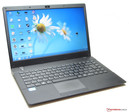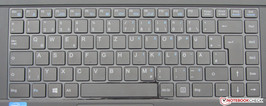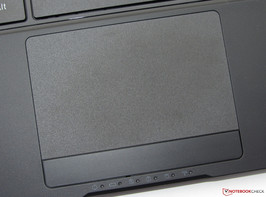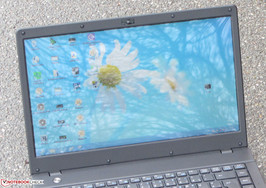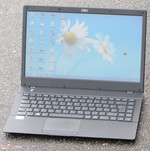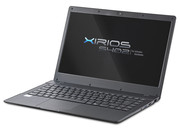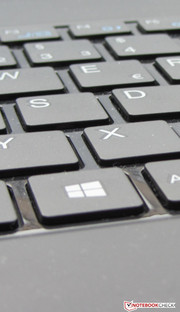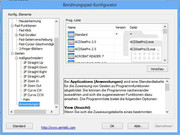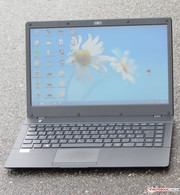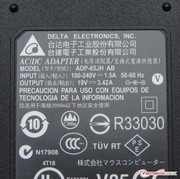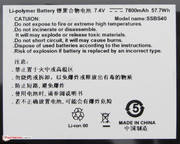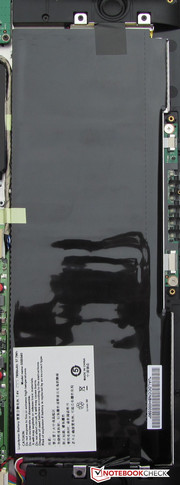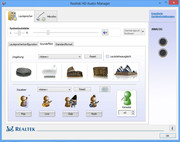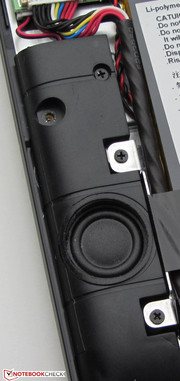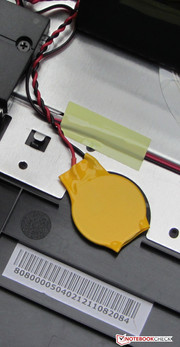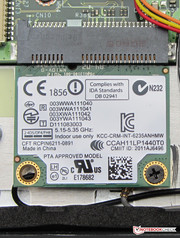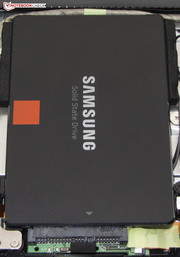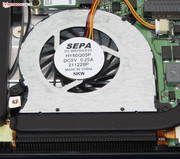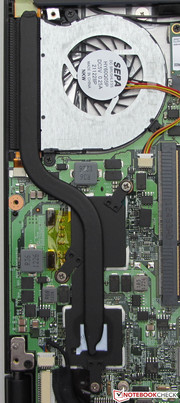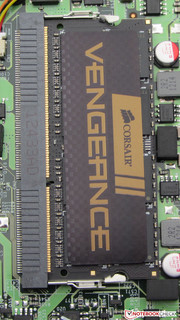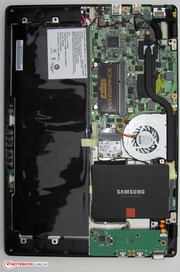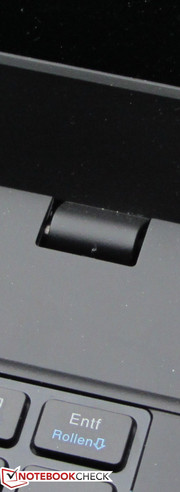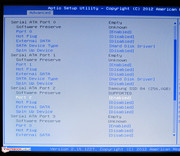Review Schenker XIRIOS S402 Ultrabook

For the original German review, see here.
Schenker is known for customizable laptops based on barebones builds from the Far East. Schenker has a range of laptops for the business user with its Xirios series. The Xirios S402 that we have reviewed is a 14-inch ultrabook from this range. Our test configuration costs approximately 1100 Euros (~$1450). The Wortmann Terra 1450 II is based on the same barebone model as the S402. Our review reveals whether Schenker offers the right mobile companion for daily business use with the S402.
We used Toshiba's Satellite U940-101 (Core i5-3317U, HD Graphics 4000), HP's Envy 4-1000sg (Core i3-2367M, HD Graphics 3000) and Fujitsu's LifeBook U772 (Core i5-3427U, HD Graphics 4000) as examples of the business laptops to classify the device.
Case
The Xirios is clad completely in black. The base is comprised of a matte-black aluminum tray and the lid features brushed, black aluminum. The display bezel and the base cover are plastic. Both exhibit a matte and slightly roughened surface. The ultrabook conveys a serious impression and does not distract from work with any embellishments. Plastic prevails on the Envy 4. HP relies on aluminum only in the areas of the wrist rest and lid. Toshiba exclusively uses plastic for the Satellite. Buyers get a much higher-quality casing with the LifeBook, which is completely made of magnesium alloy.
The aluminum tray gives the base unit high torsional stiffness. It is virtually impossible to twist it. Even the plastic top proves to be stable. The wrist rest only yields marginally under pressure. It only dents slightly above the touchpad. A major processing flaw is found on the right edge of the wrist rest. It creaks because the base unit's top and bottom are not firmly connected here. The top can be lifted to create a gap in this area. It simply lacks an additional screw on the bottom. This is also noticed on the left side, though not as severe.
The lid is not quite as stiff as the base unit. However, warping it does not cause image distortions. The rear proves to be rigid and hardly dents. The hinges keep the lid firmly in position and only rock marginally. The lid can be opened easily with one hand.
Connectivity
The Xirios sports the usual interfaces and consequently does not differ much from its rivals. However, the Xirios is the only one of our four in the list that features a VGA port. All the other ultrabooks have at least one USB 3.0 port. The LifeBook U772 is the only laptop with a docking port, which adds further interfaces. The interface positioning on the S402 is intelligent. All ports are towards the rear on both sides. This prevents cables causing obstructions near the wrist rest.
Communication
Our test device sports an Intel Centrino Advanced-N 6235 Wi-Fi module that supports the 802.11 a/b/g/n standards. The module also adds Bluetooth version 4.0 to the laptop. Beyond that, the module also supports Intel's Wireless Display Technology, which connects suitably equipped monitors via Wi-Fi. We did not have problems with Wi-Fi reception. The Wi-Fi indicator always exhibited full signal strength in both immediate proximity (approx. 3 meters) as well as two stories below the router (transmission performance: 50 percent). The built-in 1.3 megapixel webcam makes pale and pixelated pictures.
Security
The Xirios S402 features a Kensington lock slot for securing the device against theft to an extent. It does not feature a Trusted Platform Module. Users who require this feature will find one in the LifeBook U772.
Accessories
There isn't much included. The ultrabook comes with a driver DVD and installation DVD for Nero 10 Essentials.
Operating System and Recovery
Our test device is configured with Windows 8 64bit. An installation DVD is not included. The Xirios is also available with Windows 7 in Schenker's online shop. We would recommend creating a recovery data carrier (like a USB flash drive) to access the recovery system in case of a Windows defect. To do this, the search function of Windows 8 is opened via the Windows key combination ‘+’ ‘Q’ and the term "create recovery drive" is entered in the search box. This opens an icon for starting the corresponding program.
Maintenance
The Xirios S402 is quite easy to maintain. Although there is no maintenance cover, the bottom is easy to remove. The user can access the hard disk, battery, fan, Wi-Fi module, BIOS battery and working memory.
The S402 only sports one memory slot. Consequently, the memory only operates in single-channel mode and the optimal performance that is available with dual-channel memory is unfortunately not available for the user. Our test device sports an 8 GB module which is the maximum capacity. Schenker implements a 2.5-inch SSD, which can be easily replaced by another model.
Warranty
Schenker includes a 24 month warranty, including pick-up service, on its Xirios within Germany. The Satellite and Envy 4 both have the same warranty period. The warranty can be upgraded to either 36 months or 48 months when the device is directly bought from Schenker. This costs an additional 105 Euros (~$140) and 210 Euros (~$280) respectively.
Input Devices
Keyboard
The main keys in the chiclet keyboard are of size 15 x 15 mm. The keys exhibit a short drop and well-detectable pressure point. The keyboard rocks a bit on its right while typing on it. Typing on the keyboard proved to be very pleasant. Schenker regrettably frames the keyboard in glossy plastic, which attracts fingerprints like magic.
Touchpad
A conventional touchpad of size 9 x 5.6 cm is installed in the S402. The multi-touch capable pad has a lightly roughened surface that does not impair the finger movement during normal operation. However, it is not very suitable for precise mouse navigation as needed in image editing. The surface slows the finger down too severely in this case and thwarts the necessary precision. The single gestures can be turned on and off in the setup menu. Moreover, gestures for starting specified applications can be assigned. Both mouse keys corresponding to the pad feature a short drop and are clearly audible and have a palpable pressure point.
Display
The Xirios' glossy 14-inch screen features a native resolution of 1366 x 768 pixels. According to Schenker's website, the S402 will also be available with a non-glare screen in late February at the earliest. However, retailers (like Notebooksbilliger.de) already sell it with a matte screen. The identical Wortmann Terra 1450 II sports a matte screen.
The screen in our test model does not belong to the brightest of its kind. The average brightness of 144.8 cd/m² is within a low range. The S402 is designed to be a mobile work device. This makes a bright screen compulsory so that content remains legible even in bright surroundings. The screen in the Envy 4 (164.8 cd/m²) features a higher brightness and so do Toshiba's ultrabook (220.9 cd/m²) and the LifeBook (191.4 cd/m²).
| |||||||||||||||||||||||||
Brightness Distribution: 82 %
Center on Battery: 143 cd/m²
Contrast: 327:1 (Black: 0.44 cd/m²)
39.5% AdobeRGB 1998 (Argyll 3D)
56.6% sRGB (Argyll 3D)
38.46% Display P3 (Argyll 3D)
The screen's contrast of 327:1 and black value of 0.44 cd/m² could also be better. The screens in the Satellite (210:1; 1.12 cd/m²), Envy 4 (165:1; 1.1 cd/m²) and LifeBook (142:1; 1.38 cd/m²) achieved much lower values. The Xirios screen can neither reproduce the AdobeRGB nor sRGB color spectra.
We measured this before calibrating the screen (state of delivery). Here we ascertained a massive DeltaE 2000 deviation in the blue, cyan, white and gray bands.
The Xirios should not be used in bright surroundings outdoors. The screen's low brightness alongside its glossy surface thwarts any attempts in this direction.
Performance
The Xirios can be customized in Schenker's online shop. Our test model belongs to the most expensive configurations with a price of just under 1100 Euros. The least expensive model is available for 679 Euros (~$900) and includes a Core i3-3217U processor, 4 GB RAM and a 500 GB hard disk. The customer can choose between Windows 7 and Windows 8 for the ultrabook. As an alternative to Schenker's online shop, the S402 is also sold preconfigured at well-known online retailers (e.g. Notebooksbilliger.de).
Processor
Our test device sports the strongest CPU that Schenker offers for the S402: Intel's Core i7-3517U. The dual-core CPU comes from the Ivy Bridge processor range and features a base clock of 1.9 GHz. Its speed can be boosted to 2.8 GHz (both cores) or 3 GHz (one core) via Turbo. This ULV processor can run with a particularly low voltage which results in a low power consumption.
The processor finished the Cinebench tests with fully enabled Turbo (2.8 GHz). One core was also occasionally boosted to 3 GHz in the single-thread test. The S402 places itself ahead of Toshiba's laptop (Core i5-3317U, HD Graphics 4000) and the Envy 4 (Core i3-2367M, HD Graphics 3000) since it has the stronger processor in the CPU tests. The Satellite and S402 are very close in Cinebench R10's GL tests. The GPU has more impact on the score here. The LifeBook (Core i5-3427U, HD Graphics 4000) clearly lags behind both its rivals because its GPU cannot perform the tests at full performance. The U940 has a clear lead on the Xirios and the LifeBook in Cinebench R11.5 GL tests, despite having the same GPU. The U940's RAM running in dual-channel mode is noticed here. The Envy 4 lags behind the others.
System Performance
The Xirios works smoothly and fast owing to the solid state drive and the Core i7 processor. The good score in PCMark 7 strengthens this impression. HP's Envy 4 (Core i3-2367M, HD Graphics 3000) and Toshiba's Satellite U940 (Core i5-3317U, HD Graphics 4000) remain behind the S402. Both machines sport a conventional hard disk that is supported by an SSD cache. However, the Satellite is very close to the S402. The U940 almost achieved the same Entertainment and Computation score as the S402. And it also benefits from its dual-channel RAM in this test. The LifeBook U772 (Core i5-3427U, HD Graphics 4000) marginally surpasses the Xirios.
| PCMark 7 Score | 4862 points | |
Help | ||
Storage Devices
The test model we were provided with was configured with a solid state drive from Samsung, the SSD 840 Pro. This SSD has a capacity of 256 GB. Samsung's SSD scored quite well with 21 MB/s in the 4K read test on running the AS SSD benchmark. This test is relevant since a lot of data is stored in blocks with a size of 4kb. However, AS SSD recorded an unexpectedly low read and write speed of 267.67 MB/s and 245.15 MB/s respectively. This SSD can reach almost twice as high speeds (see comparison chart).
It seems that the hard disk is connected in SATA II mode (max. 3 GBit/s) although the disk and chipset supports the SATA III mode (max. 6 GB). The HM76 chipset implemented in the Xirios provides a total of 6 SATA ports of which only two support SATA III. A look in the BIOS reveals that the SSD is connected to SATA port 2. However, only ports 0 and 1 support SATA III. Schenker connected the hard disk to one of the slower ports. The SSD is not being used to its fullest. It is not possible to change that.
Those who use the Xirios with a conventional hard disk will not notice this constraint. Conventional hard disks work much slower than solid state drives and consequently, the slower SATA port is not noticed.
| AS SSD - Seq Read (sort by value) | |
| Schenker XIRIOS S402 | |
| Fujitsu LifeBook U772 | |
| HP EliteBook Folio 9470m H4P04EA | |
| Schenker XMG A701 | |
| Nexoc B510 | |
| Tarox Modula Ultrabook i7 | |
| Samsung SSD 840 Pro 256 GB Desktop | |
| AS SSD - 4K Read (sort by value) | |
| Schenker XIRIOS S402 | |
| Schenker XMG A701 | |
| HP EliteBook Folio 9470m H4P04EA | |
| Fujitsu LifeBook U772 | |
| Tarox Modula Ultrabook i7 | |
| Nexoc B510 | |
| Samsung SSD 840 Pro 256 GB Desktop | |
Graphics Card
The Intel processor in the Xirios also integrates a graphics core dubbed the HD Graphics 4000. It supports DirectX 11 and clocks at a frequency ranging from 350 to 1150 MHz.
The 3DMark benchmark scores are on a par with the Satellite. Toshiba's laptop (Core i5-3317U, HD Graphics 4000) only has a clear advantage in 3DMark 06. The U940 can fully exploit its dual-channel RAM in this benchmark. The Envy 4 (Core i3-2367M, HD Graphics 3000) cannot keep up with these ultrabooks due to its inferior GPU. The LifeBook (Core i5-3427U, HD Graphics 4000) does not achieve the scores of the Xirios or Toshiba devices despite having the same GPU. The U772's GPU does not work at its maximum frequency.
| 3DMark 05 Standard | 7136 points | |
| 3DMark 06 Standard Score | 4226 points | |
| 3DMark Vantage P Result | 2932 points | |
| 3DMark 11 Performance | 603 points | |
Help | ||
Gaming Performance
The Xirios S402 is not conceived as a gaming laptop due to the integrated GPU. The HD Graphics 4000 can nevertheless render many games at a low resolution with low quality settings smoothly. It fails with up-to-date games with high requirements like Hitman: Absolution. Games like from the FIFA run smoothly at the screen's native resolution and medium quality settings because they only have low requirements on the GPU.
The Xirios could achieve even better frame rates had the RAM run in dual-channel mode. But this is not possible since only one memory bank is available. The difference is seen in a direct comparison with the Satellite using the game Anno 2070. Both ultrabooks have 8 GB of RAM, but it operates in dual-channel mode in the Satellite.
| low | med. | high | ultra | |
|---|---|---|---|---|
| The Elder Scrolls V: Skyrim (2011) | 24.2 | 13.4 | 7.9 | |
| Anno 2070 (2011) | 37.3 | 19.3 | 12.4 | |
| F1 2012 (2012) | 32 | 26 | 21 |
| Anno 2070 | |
| 1024x768 Low Preset (sort by value) | |
| Schenker XIRIOS S402 | |
| Toshiba Satellite U940-101 | |
| 1366x768 Medium Preset AA:on (sort by value) | |
| Schenker XIRIOS S402 | |
| Toshiba Satellite U940-101 | |
| 1366x768 High Preset AA:on AF:2x (sort by value) | |
| Schenker XIRIOS S402 | |
| Toshiba Satellite U940-101 | |
Emissions
System Noise
The Xirios proves to be exemplarily quiet when idling. We measured a noise development of 31.1 dB. The fan is never inactive but it is virtually silent. The LifeBook (28 dB to 33.2 dB) runs quieter while both the Satellite (31.6 dB) and Envy 4 (30 dB - 37.9 dB) produce more noise. The Xirios reached a very loud 43.6 dB at both medium load (via 3DMark 06) and full load (stress test via Prime95 and Furmark). The Envy 4 (38 dB and 40.4 dB), the LifeBook (39.2 dB and 40.1 dB) and the Satellite (37.6 dB and 42.3 dB) produce less noise.
There is a second noise source besides the fan in the Xirios. Every time the SSD was intensely loaded, for example during the AS SSD benchmark, we heard an annoying electrical hissing noise.
Noise level
| Idle |
| 31.1 / 31.1 / 31.1 dB(A) |
| Load |
| 43.6 / 43.6 dB(A) |
 | ||
30 dB silent 40 dB(A) audible 50 dB(A) loud |
||
min: | ||
Temperature
The temperatures never surpassed 30 degrees Celsius on the top and bottom of the case while idling. It is obvious that a Core i7 processor is installed in the device during full load. We measured temperatures ranging from 28.4 to 52.4 degrees Celsius. The ultrabook should not be placed on the lap in this state. The LifeBook heats up to a similar extent as the Xirios. The Envy 4 and Satellite produce more heat over the entire load range. Both devices surpass 60 degrees Celsius during full load.
The CPU processed the stress test (Prime95 and Furmark run for at least one hour) at 1.9 GHz in the AC-mode. The GPU ran at a frequency of 1000 MHz and occasional fluctuations from 950 MHz to 1050 MHz were observed. The CPU finished the stress test at 2.4 to 2.5 GHz on battery power and the GPU clocked at 350 MHz. We re-ran the 3DMark 06 benchmark right after the stress test in AC-mode. The score did not change compared with the laptop's cold state. The CPU temperature settled to approximately 85 degrees Celsius in AC mode.
(-) The maximum temperature on the upper side is 52.4 °C / 126 F, compared to the average of 35.9 °C / 97 F, ranging from 21.4 to 59 °C for the class Subnotebook.
(-) The bottom heats up to a maximum of 51 °C / 124 F, compared to the average of 39.3 °C / 103 F
(+) In idle usage, the average temperature for the upper side is 25.8 °C / 78 F, compared to the device average of 30.8 °C / 87 F.
(+) The palmrests and touchpad are cooler than skin temperature with a maximum of 31.9 °C / 89.4 F and are therefore cool to the touch.
(-) The average temperature of the palmrest area of similar devices was 28.2 °C / 82.8 F (-3.7 °C / -6.6 F).
Speakers
The stereo speakers are located on the bottom of the Xirios. They produce a thin, low-bass sound. Speech is intelligible. The sound can be modified via the Realtek HD Audio Manager. It is also possible to connect external speakers or headphones instead of using the internal speakers.
Energy Management
Power Consumption
The Xirios prove to be very conservative with an idle power consumption between 5.8 and 9.2 watts. The Satellite (6.7 to 10.3 watts) and Envy 4 (6.1 to 8.5 watts) are not power guzzlers either. The LifeBook U772 proves to be most energy-efficient (4.4 to 8.7 watts). The power consumption increased to 35.6 watts in the medium load range (3DMark 2006). Thus, it consumes more than the Satellite (38.1 watts) and less than HP's laptop (28.5 watts) and the LifeBook (34.1 watts). We measured a marginally higher consumption of 36.4 watts during full load (stress test via Prime95 and Furmark) since the CPU ran the stress test without Turbo. The power consumption of the Envy 4 (36.3 watts) is on a par with the S402 while the Satellite (41.3 watts) as well as the LifeBook (37.5 watts) consumes more energy.
| Off / Standby | |
| Idle | |
| Load |
|
Key:
min: | |
Battery Runtime
The Xirios S402 proved to be a real endurance machine. It reached an idle runtime of 11:58 hours. The Satellite (6:27h), Envy 4 (8:05h) and the LifeBook (9:28h) do not come close to that. The idle runtime was ascertained using BatteryEater's Reader's test. The screen is set to minimum brightness, the energy-savings profile is enabled and the wireless modules are disabled. The battery in the S402 was drained after 1:42 hours of load. The Satellite (1:18h) and Fujitsu's ultrabook (1:37h) shut down earlier. The Envy 4 (2.23h) lasted longer than the others. The load runtime is ascertained using BatteryEater's Classic test. The screen is set to maximum brightness and the high-performance profile and wireless modules are enabled.
The Xirios finished the Wi-Fi test after 6:54 hours, which is a good time. The rivals cannot match that(Toshiba: 4:05h; HP: 4.20h; Fujitsu: 5:17h). Websites are automatically opened every 40 seconds in the Wi-Fi test. The energy-savings profile is enabled and the screen's brightness is set to approximately 150 cd/m².
It is not surprising that the Xirios does this well. It sports the battery with the highest capacity (Schenker: 57.7 Wh; Toshiba, Fujitsu: 45 Wh; HP: 52 Wh) and is very energy efficient when idle.
Verdict
With the Xirios S402, Schenker offers a light, mobile ultrabook that excels with very good battery runtimes. It also provides good application performance and scores with a rigid casing, which however exhibits some production flaws (creaking). We also like the ease of maintenance. Moreover, we did not notice throttling in the Core i7 processor. The screen is not one of the S402's strengths. It is rather dim and has a low contrast. The RAM cannot run in dual-channel mode since there is no second memory bank. Thus, the CPU and GPU are not optimally maxed out. Beyond that, the SSD is slowed down because a slower SATA port is used.
Those looking for an enduring ultrabook could risk taking a look at the S402. There is room for saving some money. If the power of a Core i3 processor and a smaller SSD or conventional hard disk is enough, the S402 is available for just under 700 Euros (~$925). The LifeBook U772 starts at 1000 Euros (~$1300) in the simplest configuration. However, it features a docking port and TPM. Both the Envy 4 and Satellite have a hard time in a direct comparison to the Xirios since they hardly stand out. The Satellite might come in question when a brighter screen is wanted. The Envy 4 undercuts the Xirios starting price by around 60 to 70 Euros (~$75 to $90).




